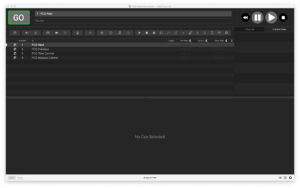
QLab will default to 1:00:00:00 every time, so you will need to customize this for each piece you do. Start Time: Timecode is based off of a 24 hour time with hours, minutes, seconds, and frames as devisions of time. 24 frames is a bit trickier when I want to do certain divisions of time (this is just the math in my head- no actual complicated mathematical stuff), so 30 fps it is. I pick 30 fps non-drop because it’s the easiest for me to work with. I’m using 1+2 for the stereo output for the music playback, so channel 3 is for the LTC output.įramerate: Frames are how Timecode divides each second.
QLAB RENTAL PRO
I have a Saffire Pro 40 (overkill and too complicated to easily recommend to many), so I have selected that.Ĭhannel: The output on the device you wish to use. Type: You want to select LTC here, since that’s the protocol we are using.ĭestination: You can choose from multiple audio interfaces if you have them (for instance, built in audio and the Peavey device I mentioned earlier). A lot of decisions happen here, so let’s go through it. Select the Timecode cue, go to Settings for that cue. Next, look for the clock icon in QLab that represents a Timecode cue and drag it into the Group cue as well.īy default, QLab is going to assume a Midi timecode cue. We want this so Qlab will start our playback file (for the dancers in our example) and our Timecode file (for the console) at the same time.ĭrag in any music file you want to use for your music playback/dancers. Select the Group cue, go to Mode and Select Timeline- Start all children simultaneously. Over in Qlab, we are going to drag in a Group cue. If you are connecting through USB, make sure USB MIDI/SMPTE is enabled as well.
QLAB RENTAL CODE
On the console, go to Setup>System Settings>Show Control>SMPTE and make sure at least SMPTE Time Code RX (RX=receive) is enabled. Connect your Response Gateway to a POE network switch connected to the console or connect the Gateway via USB.
QLAB RENTAL PATCH
We will start in the EOS Family Level 4 Complete show file (found on ) to bypass the need to patch and write cues.

QLAB RENTAL LICENSE
A Mac with a QLab Audio license installed.You can then use your built in output for the music and the Peavey for the LTC. If you want a suggestion for the cheapest option, I would buy a Peavey USB-P which will add two XLR outputs to your computer for $50. You can find many audio interfaces for purchase that offer four outputs. Since no computer (that I know of) comes with more than one stereo audio output, this means you need to source an audio interface that will output for playback of music (which can be as little as 2 channels of output for the L and R signal from the stereo file) as well as the one output (LTC is a mono sound, meaning only one channel of output). My use-case situation is a dance recital, which will want recorded playback of music as well as output for LTC. A reader asked if there was a way to do LTC via network and QLab strongly recommends against such a thing since a typical network is filled with interruptions to a perfect data flow that will make synchronizing very frustrating or impossible. If you want LTC (Linear Time Code), you must have dedicated ETC hardware such as this or the older Show Control Gateway. But if you can source them, I promise that LTC is worth the fuss. There are items needed for this project that are not always easy to get ahold of. This time, we will explore sending LTC Timecode from QLab to EOS to trigger cues.
QLAB RENTAL SERIES
*Access to the more elaborate sound system is available if you employ a Constellation sound engineer for $25.00 an hour in addition to the LD PSM that we already provide you with.ĬLICK HERE for a list of additional equipment that would be available to you.Welcome back to the second in my little series of linking Qlab and EOS.

**Studio B is not available to rent for performances if you have not produced at Links Hall previously, opportunities to perform in studio B are based on past ticket sales not on artistic preference**


 0 kommentar(er)
0 kommentar(er)
